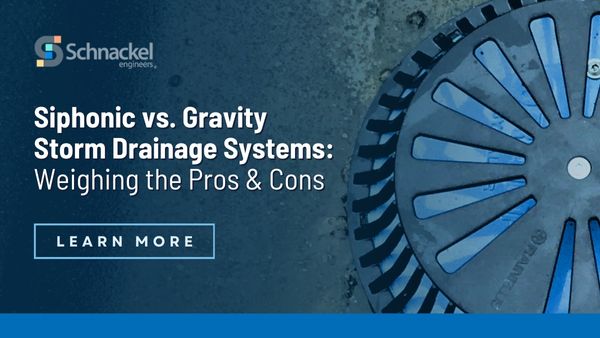Siphonic vs. Gravity Storm Drainage Systems: Weighing the Pros and Cons

When designing a storm drainage system for a building, choosing between siphonic and gravity drainage systems is a crucial decision that impacts both performance and cost. Each system has its own unique advantages and limitations, making it essential for architects and project owners to understand how they work. In this blog, we’ll compare siphonic drainage systems to gravity drainage systems, discussing their key differences, benefits, drawbacks, and ideal applications.
By the end of this blog, you’ll have a better understanding of which drainage system might be the best fit for your next project, whether you’re dealing with large or smaller commercial buildings.
What is a Siphonic Drainage System?
A siphonic drainage system relies on the principles of siphon action to efficiently remove rainwater from roofs. These systems use negative pressure to create a vacuum effect in the piping network, allowing rainwater to be carried away through smaller diameter pipes. The siphon effect accelerates the water flow, making it more efficient compared to gravity systems. This results in reduced piping requirements and faster drainage, especially beneficial for large or flat roofs.
What is a Gravity Drainage System?
A gravity drainage system, on the other hand, uses gravity to move rainwater from a roof to a drainage system. Water flows downhill through large-diameter pipes, relying on slope to transport the water. Gravity systems are the traditional method used in most buildings, and they require a well-maintained slope to ensure that water flows efficiently towards the drains.
What’s the difference between Siphonic and Gravity Drainage Systems?
Functionality and Operation
Siphonic drainage systems rely on the vacuum effect generated by negative pressure within the pipes to efficiently move water off the roof. This siphonic action accelerates the flow of water, allowing the system to handle larger volumes with smaller pipes compared to gravity systems. The result is a more efficient and compact drainage solution that is ideal for large, flat roofs or areas with high rainfall. In contrast, gravity drainage systems function by using gravity to move water downhill through large pipes and drains. While gravity systems are simpler and more traditional, they require a specific slope to function effectively. Without the right pitch, water flow may slow down, and drainage efficiency may be compromised.
Pipe Size and Piping Requirements
One of the significant advantages of siphonic systems is their use of smaller pipes, which reduces the amount of piping needed overall. This not only lowers material costs but also cuts down on installation time. Additionally, the smaller pipes offer more flexibility in terms of placement within the building, making it easier to design and install a drainage system that fits into tighter spaces. Conversely, gravity systems require larger-diameter pipes to move water effectively, which can take up more space and increase both material costs and installation time. This can be especially challenging in larger buildings where roof space is limited, or when dealing with complex layouts that require extensive piping networks.
Pros and Cons of Siphonic Drainage Systems
Pros:
- Increased Efficiency: Siphonic drainage systems are better at handling high volumes of rainwater quickly. The siphonic action accelerates water movement, making them ideal for large roofs or areas with heavy rainfall.
- Reduced Piping Needs: With smaller pipes required, the overall material and labor costs are reduced. Fewer drains and piping make the system more compact and efficient.
- Design Flexibility: The system’s smaller pipes offer greater flexibility in roof design. It allows for more space utilization and eliminates the need for slopes, making it ideal for complex roof structures.
- Fewer Maintenance Requirements: Siphonic systems are less susceptible to blockages due to the siphonic energy in the system.
Cons:
- Complex Design and Installation: Siphonic drainage systems are more complicated to design and install due to the specialized piping and technology involved.
- Higher Initial Costs: Though they save on material costs due to smaller pipes, the technology and specialized installation can make siphonic systems more expensive upfront.
Pros and Cons of Gravity Drainage Systems
Pros:
- Simplicity and Reliability: Gravity drainage systems are the traditional choice and are simpler to design, install, and maintain. Their operation is easy to understand, making them ideal for less complex roof designs.
- Lower Upfront Costs: Gravity systems are generally less expensive to install due to the simplicity of their design and fewer specialized components.
Cons:
- Space and Design Limitations: Large pipes and the need for a slope can limit roof design flexibility. The system can take up more space, especially in buildings with complex layouts.
- Slower Water Drainage: Gravity systems can struggle to remove large volumes of water quickly, particularly during intense rainfall, leading to pooling and possible water damage on the roof.
- Drainage Constraints: Gravity drainage systems are less effective in regions with heavy rainfall or in buildings with flat roofs where water flow is less efficient.
- More Maintenance Requirements: Gravity systems typically experience more blockages and require more maintenance over time compared to siphonic systems.
Final Thoughts
Both siphonic and gravity drainage systems have distinct advantages, and understanding their differences is key to making an informed decision for your project. Siphonic systems are efficient, flexible, and ideal for large, complex roofs, especially in areas with heavy rainfall. However, gravity systems are simpler, more cost-effective, and reliable for smaller or traditional buildings with less demanding drainage needs.
By evaluating factors such as budget, roof design, climate, and long-term maintenance, you can select the best drainage system for your building project, ensuring optimal performance and longevity.
Ready to optimize your building’s storm drainage system?
Contact us today to discuss how our engineering expertise can help you design the most efficient and cost-effective drainage solution tailored to your needs. Let’s make your project a success with the right drainage system!
Comments